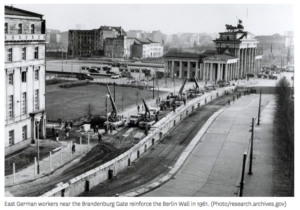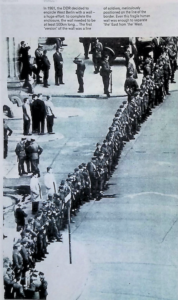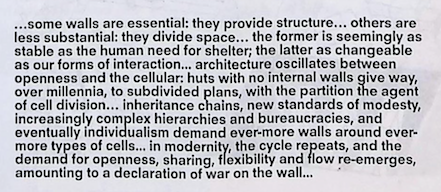Return to VJIC Table of Content
Return to Theme Table of Content
A short visual bibliography around the idea of a Wall
By: Stefano Ruffa
Essay 1: The Berlin Wall rise and fall and some other considerations
Stefano Ruffa is a photographer, curator, gallery owner, bookseller. His life is spent working between media & cultural studies and photography. Stefano Ruffa is the founder, curator and director for the ONEROOM Lab and Bookstore located in Rome, Italy.
INTRO
An experience designed like a map to get lost among the pages
of books, images, sounds and a narrating voice,in a time and
space that expands with each step and play a strange circle
between the walls of yesterday and the divisions of today.
A multidimensional maze of stories and languages which, leading
us to an impervious path, provide us with the skills necessary to
move with greater awareness among the very personal walls
of our beliefs, and also to offer us the tools necessary to let
new light bring in unexpected horizons, finding the way to
build a better tomorrow together.
Thirty years ago or a little more, a Wall fell. An important one, a watershed in history. It was a 156 km line of concrete in the heart of a city, in the heart of Europe, dividing the World in two. Height just over three meters, but inviolable as if it went up in space, beyond the Moon.
 It was not a work of high engineering indeed, especially in the early years it showed up as an informal barrier of barbed wire, woods, and debris; then trenches, Friesland horses and towers surveillance. (1) Indeed, in its very first version, it was nothing more than a row of men who became an ideology (2) and structure. Nonetheless impassable. (3) To keep inside who is inside and outside who is outside; to leave no room for nuances and distinguish on who we are and who they are, who is a friend and who the enemy.
It was not a work of high engineering indeed, especially in the early years it showed up as an informal barrier of barbed wire, woods, and debris; then trenches, Friesland horses and towers surveillance. (1) Indeed, in its very first version, it was nothing more than a row of men who became an ideology (2) and structure. Nonetheless impassable. (3) To keep inside who is inside and outside who is outside; to leave no room for nuances and distinguish on who we are and who they are, who is a friend and who the enemy.
II

Berlin Wall started with soldiers. Rem Koolhaas & Irma Boom, Elements of Architecture, Taschen 2018
It was an August night in 1961 and the Earth woke up with a new scar;
yet another laceration caused by ulcers hatched in previous decades, one of the longer and darker nights of our reason, which too often continues to doze off. The sleep of reason generates monsters, one of them is war. (4) The most common nightmare. (5)
From Vienna to Sarajevo via Paris and Warsaw, from Berlin to Rome (6); Europe to the Americas, from Africa to Japan, moving from year to year toward a closer East.
But that still does not let dawn be seen. (7)
Narcolepsy of the intellect, perhaps this is the illness that afflicts us more than others. Or perhaps, more simply, war and violence are characteristics inherent in the human soul, which we pour into the world through words, thoughts and actions, every time (8) we meet someone standing on the other side of some kind of wall. The wrong one.
Interlude
A small interlude to illustrate a nuance that is lost in the narrative, but it is an integral part of the complete experience of the journey presented here, born in the context of a room that is less and less a bookstore and more and more open studio and specialized library in uncommon and rare contemporary photo books: the last title cited, Language is war by Fabio Mauri, is reported and illustrated, proposed to deepen, but without having and offering real access to it.
It is a rare and sought after book, and the market says it is worth more than I can afford. Not for the importance of its content is clear, but for the scarcity of its availability. After all, that’s how you calculate the value of an object, considering too often only one possible meanings of the term ‘value’, the economic one, not capturing other possible variations.
Building a wall that leaves us all shut out from the knowledge of those pages, allowing us only to peek at the cover surface through the windows in our browsers of some online ads.
And a third rereading of Bertolt Brecht’s work (9) offers us a convenient passage for ending the break and returning to our path.
III
Going back on our steps we find a transformed world.
A breach in a wall, a door opened almost accidentally on a November evening in 1989 suddenly erase old distinctions, by starting a fast transition from a side 10, and fueling the illusion of a World finally made of “Us” on the other. (11)
By asking several questions. (12) Watching on television the images of that incredulous people freely in transit through a checkpoint for the first time in decades, Laurie Anderson recognizes in those gazes something familiar. (13)
Video source CNN, downloaded from YouTube, Feb. 7, 2021
The sparkle of a burning desire, a hatched flame too long under the ash of austerity: not craving for freedom, but consumption. People in line at bank counters claiming the 100 Deutsche Mark as “welcome gift” offered from a generous Federal Germany to the newly found Eastern brothers (14), followed by rows in the wealthy boutiques on the Western streets, from whose windows appears the bright and luxuriant forbidden fruits of our Eden.
The “Short Century” ended in those days, a decade ahead of schedule, letting us foresee the frenzy that has accompanied us since then. The speed of technological innovation spread on an ever so large scale, the passage from an analog world to a digital one, hyper-connected and immediate, it has brought down the walls of time and space; East and West, North and South, the Earth now own the tools to get to know each other, to see each other, to speak directly.
To hug in a happy embrace …
We weren’t ready yet, and we aren’t now.
First (15) and last (16) generations dealing with a new World, but without any instruction manual to make it understandable; missing the known coordinates, to universals questions about ‘Who we are’ and ‘Where are we going’ adds a third fundamental question: Where are we now?
Even the best maps, if we don’t know our location, become of little use.
Of course, we have GPS and wearable devices that allow our community to follow each of our steps in the four corners of the world, and then share what we see, what we hear, the beating of the heart and why not even the smells from here shortly.

Rem Koolhaas & Irma Boom, Elements of Architecture, Taschen 2018
An extended and shared hybrid body. Among the members of our community.
Chosen less and less on a geographical basis and more and more by the affinity of interests and points of view. To find confirmation of our idea of the World and not to feel lost and isolated. In the most extreme cases, doing the screens that function a few years ago it was intended for mirrors, magical or not.
Diverging visions, discouraged by annoyance and algorithms, disappear from the flow of our feed, from our horizons, from our perceptions, comparing (or comforting) us only between our fellows we lose much of the sensitivity of our “social skin”, reinforcing beyond our beliefs and disbeliefs and losing availability and ability to dialogue with those who look at things from a different perspective. (17) Perched in defense of our little world, leaving anyone else out; enemies to fight with words and actions, which want to invade our living space, our freedom.
“Us” thus seems to be a reflected and amplified version of our self,
“Them” are just behind the Wall, and are so many: everyone else.
Return to VJIC Table of Content
Return to Theme Table of Content
1. Arwed Messmer & Annette Groenisch, Taking stock of power, Hatje Cantz 2016
2. Rem Koolhaas & Irma Boom, Elements of Architecture, Taschen 2018
3. Valerie Smith (ed.), Between Walls and Windows, Hatje Cantz 2015
4. Bertolt Brecht, Kriegfiebel, Eulenspiegel 1955 – War Primer, Libris 1998 – L’abc della guerra, Einaudi 1971
5. Adam Broomberg & Oliver Chanarin, War Primer 2, MACK Books 2018
6. Marius Constant, Nana Symphonie, 1980 (music)
Erik Kessels, Shit, RVB Books 2018
8. Fabio Mauri, Linguaggio è guerra, Marani 1975
9. Lewis Bush, War Primer 3, self-published 2018
10. Un mur a Berlin, Patrick Rotman, Kuiv 2009 (movie)
11.
a) Anthony Suau, Beyond the Fall. The Former Soviet Bloc in transition 1989-99, Silvana 2000
b) Fabio Sgroi, Past Euphoria Post Europa, Crowdbooks 2017
12. VV.AA., Europa. An illustrated guide to Europe for migrants and refugees, Al-liquindoi 2016
13. Laurie Anderson, All the things I lost in the flood, Rizzoli Electa, 2019
14. Tommaso Bonaventura, Agnese Del Prete, 100 DM, Silvana Editoriale, 2019
15. Martin Kollar, Provvisonal Arrangments, MACK Books 2015
Kristin Trub, Letze Generation OST, Edition Bessard, 2015
Elisabeth Noelle-Neumann, La spirale del silenzio, Meltemi 2001
[The spiral of silence, University of Chicago Press, 1980]
Return to VJIC Table of Content
Return to Theme Table of Content
